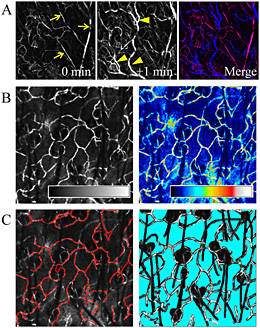Research Abstract
2光子顕微鏡を用いたマウスにおける血管透過性の生体内解析
Intravital analysis of vascular permeability in mice using two-photon microscopy
2013年6月4日 Scientific Reports 3 : 1932 doi: 10.1038/srep01932

血管内皮は半透過性のバリアを形成し、その透過性は血漿内容物の輸送を調節している。今回我々は、2光子顕微鏡を用いたマウスにおける血管透過性の生体内評価法について報告する。我々は、さまざまなサイズの蛍光標識デキストランを静脈内に投与し、その流出を、血管内と血管外間質の蛍光強度の経時変化を測定することで定量化した。その結果、皮膚の血管が恒常的な条件下において70 kDaよりも大きいデキストランの通過を制限することを証明した。次に我々は、ヒスタミンもしくはIgE誘導性のI型アレルギーモデル、およびハプテン誘導性IV型アレルギーモデルにおいて血管透過性の動態を評価した。このような炎症状態では、透過性の亢進は後毛細管静脈に選択的に誘導され、2000 kDaの大きさのデキストランが血管から漏出した。今回報告した研究手法は、輸送バリアとしての血管の機能を生理的な条件下で簡便に解析するツールを提供する。
江川 形平1, 中溝 聡1, 夏秋 洋平1, 土居 博美1, 宮地 良樹1 & 椛島 健治1
- 京都大学大学院 医学研究科 皮膚生命科学講座
Blood vessel endothelium forms a semi-permeable barrier and its permeability controls the traffics of plasma contents. Here we report an intravital evaluation system for vascular permeability in mice using two-photon microscopy. We used various sizes of fluorescein-conjugated dextran as a tracer and its efflux was quantified by measuring the changes of fluorescent intensity both on the blood vessel area and the interstitial space. Using this system, we demonstrated that skin blood vessels limited the passage of dextran larger than 70 kDa under homeostatic conditions. We evaluated the kinetics of vascular permeability in histamine- or IgE-induced type I allergic models and a hapten-induced type IV allergic model. In such inflammatory conditions, the hyperpermeability was selectively induced in the postcapillary venules and dextran as large as 2000-kDa leaked from the bloods. Taken together, our study provides a convenient method to characterize the skin blood vessels as a traffic barrier in physiological conditions.

